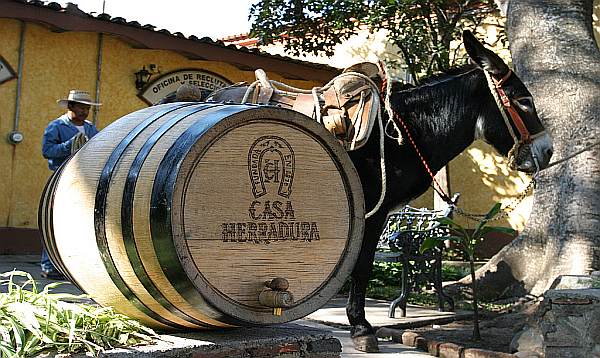As North America's first distilled drink, and its first commercially-produced alcohol, tequila's history is long and rich. Originating in the indigenous populations, transformed by foreign invasions, and finally building an identity of its own, Tequila is Mexico's most renowned liquor - and the state of Jalisco makes some of the very best in the world.
Meet the Geniuses of Jalisco... the master distillers who are turning years of history and experience into tequila perfection.
Patrón: Francisco Alcaraz
 |
Because there are no agave fields on the property, Alcaraz oversees the hand-choosing of the brand's agaves from eight local plantations. Alcaraz insists the agaves go from field to oven within 24 hours. Patrón's distillery utilizes a special combination of traditional tahona crushing methods and mechanical roller-mill shredding methods to produce its different flavor profiles. For an even smoother finish, Alcaraz brought in copper stills (as opposed to stainless steel), which turn the sulfur components produced during fermentation into liquid waste. All in all, more than 60 hands touch each bottle of Patrón before it leaves the property.
Don Julio: Enrique de Colsa
 |
Each agave piña is hand-selected, hand-chopped, and stacked in the oven, so that all are uniform and none overcook in the furnace. Every six months, a strain of the original yeast in Don Julio's recipe for fermentation is brought in from Mexico City and isolated in the distillery, where it will be used once (so that it never mutates). The new version is then transported back to the city for safekeeping.
Since Don Julio, as a brand, was a pioneer in Cristalinos as well as bottle design, de Colsa developed the exclusive Don Julio 70 Añejo Cristalino in honor of the brand's 70th anniversary in 2012. Enrique de Colsa approaches tequila much like the legendary Don Julio approached everything - with extreme seriousness and gravity - but he handles everything else life throws at him much like Don Julio's brother, Don Carlitos, who was notorious for his pranks and humor during his five-year tenure at the distillery.
Avión: Alejandro Lopez
 |
Lopez roasts the agaves in the distillery's brick ovens for two days, then allows them to rest and stew for a day before extraction, which creates more agave juice. As Avión proves, location matters: the Lopez family's agave plantation is 7,000 feet above sea level in the highlands, which gives their agaves a natural, uniquely high sugar content.
Volcán De Mi Tierra: Ana María Romero Mena
 |
More than 600 flavors are involved in developing tequila, and Mena can identify most of them by smell alone. For the brand's impressive Cristalino, Mena chose to experiment with the challenging lowlands agaves (which have an herbal and citrusy flavor, along with a distinct flavor profile thanks to dark, volcanic soil) and a very unique highlands champagne yeast. Volcán De Mi Tierra's Cristalino tequila (which just launched this year) is finished off in Möet's cognac casks for a month — Mena insists that it be served over ice.
Herradura: Maria Theresa Lara
 |
While the basic Herradura recipe has not changed since the historic distillery's inception, Maria Theresa Lara gets to experiment with external elements. This is the only tequila distillery with its own cooperage, full of 55-gallon American white oak whiskey barrels. Lara's unwavering curiosity about how far she can push the limits of tequila's flavor profiles has led to some of the brand's most popular and unique products, like Herradura Ultra (a mix of añejo and extra añejo tequilas), which is aged in those white oak barrels on-site. Herradura was also the first distillery to petition for a distinction between añejo and extra añejo.
Original article


